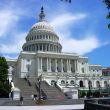In Nevada county, data underpins efforts to address climate change
Across the United States, cities and counties are doing their best to confront climate change in myriad ways—from bolstering seawalls to updating electrical grids and everything in between. But in order for communities to best direct their efforts and responsibly spend hard-earned taxpayer dollars, administrators need data.
In Washoe County and Reno, Nev., for example, community leaders are leveraging data to better understand the city’s emissions and reduce emissions by 28 percent from 2005 levels by 2025. With an increasing number of 100-plus degree days annually and smoke regularly descending on the region from nearby wildfires, the city is moving quickly.
“We’ve done several lighting retrofits city wide, we’ve expanded electric vehicles in our fleet,” said Suzanne Groneman, Reno’s sustainability program manager, noting the city has “been really heavily focused on reducing our own emissions, and our own environmental efficiencies.”
Beyond municipally owned assets, Groneman said city administrators are focused on promoting low-carbon utilities in neighborhoods, adding bike lanes, and expanding renewable energy through permitting and financing opportunities for local residents. Underpinning these and other goals–and making it possible to meet them—is data.
“I’m sure we’ve all heard the term ‘data driven decisions,’ and that’s particularly true when you’re working with taxpayer dollars,” Groneman said. “You have to rely on data—otherwise, you go in the wrong direction and you focus those dollars in the wrong places.”
To that end, the City Reno and Washoe County, Nev., the surrounding county, have partnered with nZero, a carbon management company that helps organizations understand where their emissions are coming from. According to Adam Kramer, the company’s CEO, nZero monitors three types of carbon emissions—direct emissions from vehicle fleets and chemicals like refrigerants (scope one), emissions produced by electricity (scope two), and indirect emissions created by supply chains. By first carbon mapping and analyzing utility information, vehicle telemetry and electricity usage, among other things, Kramer said, “We give them that data on a 24/7 basis so they can make decisions.”
Public understanding of climate change and how it must be confronted has rapidly changed in the last decade. Likewise, the focus on using data to inform decisions by municipal and county organizations has “evolved incredibly,” Kramer said. “Going from general statement of ‘we think climate change is important,’ to about five or six years ago—people really starting to outline climate plans—to today, not just talking about green energy, but specifically talking about carbon, and environmental impact.”
Beyond driving decisions in town hall, data has helped officials in Nevada adapt their massaging to reach disparate populations. Of all the challenges Reno has overcome since beginning to address climate change about five years ago—launched by a 2019 sustainability and climate action plan—Groneman said educating community members about the urgent need to take action has been the most challenging.
In this, leveraging data to reframe the discussion about climate change around other community issues like living conditions and costs has proven useful. It’s also helped inform decision makers understand the impact climate change is having on residents. For example, overlaying health data documenting a spike in asthma with other climate-related data could help administrators craft policy to address previously unknown challenges, Groneman said.
Witnessing the impact of a changing climate for themselves has also moved the issue forward.
“I’d say the greatest momentum has been the last two years, in terms of community interest,” Groneman said. “We’ve experienced wildfire smoke in our community for the last two summers, and that’s been an eye opener.”
In Washoe County, Kalie Work, the county’s recorder and sustainability champion, said officials there are just now embarking on a climate reduction road map.
“We’re in the early stages, and we’re just now in the process, the early stages, of hiring a sustainability coordinator,” Work said, noting they’re prioritizing collecting data in order to understand where they need to focus their efforts. “I love the quote, ‘you can’t manage what you can’t measure.’ That’s been really helpful for Washoe County. We’re looking to the data to guide a lot of that decision making.”
For other organizations interested in launching resiliency initiatives, Groneman said it’s important to first understand the data, and then look a long ways down the road.
“You have to set your long range vision and work backwards,” she said.




















